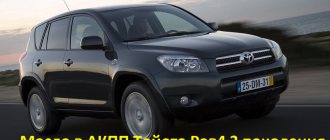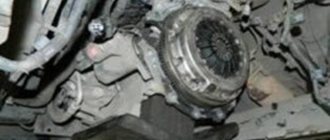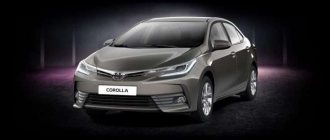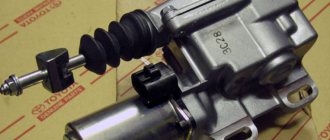Today, cars with a robotic transmission (manual transmission, AMT) are serious competitors to the classic hydromechanical automatic transmission and CVT for a number of reasons. First of all, the robotic gearbox is cheaper to produce; manual transmission also allows for high fuel efficiency, which is especially important given strict environmental regulations and standards.
At the same time, at first glance it may seem that the robotic transmission is no different from the usual automatic transmission, but this is not the case. Taking into account certain features and design differences, you need to know how to use the robot box in order to achieve maximum riding comfort and extend the service life of the unit.
see also
Comments 39
Thanks everyone for the advice)
If you are asking this question, then the robot is not suitable for you. Mode E is economical, lightly press the gas, it switches early, everything is designed for leisurely driving. Press harder, it will hold the gear further, but as soon as you let go it will shift up. Es mode is more vigorous, switching from 3 thousand or more, depending on how you press the pedal. And in general it’s more convenient in the city.
There is no need to do any initializations every 20 thousand. Everything just gets worse, and wear and tear occurs even more intensely. You won’t be able to drive like a regular automatic; you need to get used to the gearbox.
Releasing the pedal when switching helps to smooth out this moment a little, but in auto mode it is a constant guessing game)))
And in order for everything to be normal, it is advisable to initialize it every 20,000 km, then the clutch will wear out evenly and there will be no kicks. But at the same time, the memory of the brain of the box is reset, the robot begins to learn and get used to the driving style again in literally 1-2 days.
Hello Countryman! At a traffic light, in neutral, when accelerating when there is a gear change, I release the gas pedal. No need to skid. Same thing in manual mode. My father has been traveling for 4 years already. I haven't changed the clutch yet.
For me, there are two features: 1) non-sports mode for winter and warming up 2) if there is a chance of slipping, switch to manual mode so that the transmission does not change gears in vain.
In general, should you drive in sport mode?) and you don’t need to let off the gas?
There is no need to dump the gas. In sport mode there will be fewer unnecessary shifts (the gearbox adapts to the driving style), shifts are smoother and there is more traction under the gas pedal.
For me, there are two features: 1) non-sports mode for winter and warming up 2) if there is a chance of slipping, switch to manual mode so that the transmission does not change gears in vain.
Even in icy conditions you can drive off with the M2 - fewer problems
How to ride a robot? Judging by the reviews here, the guys steer with one hand and wipe away their tears with the other. Whatever the post is about replacing the clutch, then replacing it with an automatic.
Those who don’t know how to drive it are shedding tears; they sold it at 103,000 and have never seen a gear.
yes, just like with an automatic, you only need to drive in sports mode, I’m not complaining, I’m skidding and everything is super, the main thing is to get used to the gas pedal, how long you need to accelerate, so much and press
Yes, and it is advisable to drive in sport mode, it shifts less and turns the speed longer. At traffic lights it is not necessary to neutral, the clutch itself goes into the squeeze mode. In fact, there were a lot of the first Corollas on the robot with jambs, and all sorts of horror stories came from there.
Do all 5 gears work in sport mode or not?
All 5 gears work, it just keeps the revs higher. Try it, you'll understand right away.
Do all 5 gears work in sport mode or not?
yeah, the car slows down less and becomes more dynamic.
Today I tried it, it seems better to drive like this, I think a couple more days and it will be fine
At traffic lights and generally when stopping, even at an intersection, put it in neutral.
you turn on the button and go, and that’s it, that’s how I drive,
Thanks, I'll study tomorrow)
This gearbox does not like slipping, extreme heat, racing and the wrong oil. The main thing is to slightly release the gas pedal when changing gears.
Modern cars use several types of gearboxes - manual, automatic, CVT. The manual transmission is distinguished by its reliability, but requires driving skills from the driver. The automatic one is much easier to operate, but more “capricious” in technical terms. Recently, designers have released another type of gearbox - robotic. In it they tried to combine the reliability of a “mechanics” with the convenience of an “automatic”. And they succeeded - more and more automakers are equipping their cars with a robotic gearbox.
A little about the device
The essence of such a box is quite simple - there is a manual gearbox and an electronic control unit for it.
With a manual transmission, all the functions that a driver with a manual transmission had to perform (squeezing the clutch, moving the gearbox lever to the desired position) are performed by actuators - servos of the electronic unit. Thanks to this, the reliability of the gearbox has increased due to the use of classical “mechanics” and the ease of use has increased. The driver just needs to move the selector to the desired position (as in an automatic transmission) and enjoy the ride, and the electronic unit will take care of the gear shift.
With all this, many robotic boxes are also equipped with manual controls, which allows the driver to control the box independently, with the only difference - there is no need to squeeze the clutch.
Control Features
The manual transmission received some operating modes from the automatic transmission, namely:
- "N" - neutral. A mode in which torque is not transmitted to the wheels from the gearbox. That is, the engine is running, rotation is transmitted to the box, but due to the position of the gears, it is not transmitted to the wheels. Used when parking a car for a long time, before starting to move, after stopping;
- "R" - reverse movement. Everything is simple here, the driver moves the selector to this position and the car moves backwards.
Other modes of the robotic box have their own designation:
- "A/M" or "E/M" - forward movement. This mode corresponds to the “D” mode of an automatic transmission, that is, the car moves forward and the gearbox changes gears. In “M” mode manual control is performed. By moving the selector to a certain groove, the required mode is selected;
- “+”, “-” - gear switch. Short-term shifts of the selector to the “+” or “-” side ensure gear shifting in the “M” manual control mode.
How to use a robotic gearbox correctly
First of all, a robotic gearbox is actually a manual transmission in which the clutch is controlled, as well as gear selection and on/off are carried out automatically. In other words, the robotic gearbox is still the same “mechanics”, only the gears are switched without driver participation.
We also note that the robotic transmission also has a manual (semi-automatic) mode, that is, the driver can independently upshift and downshift in the same way as Tiptronic on an automatic transmission. It becomes clear that manual transmission manufacturers strive to imitate a classic automatic transmission to simplify interaction. For this reason, the robot has similar modes.
- Like the automatic transmission, there is an “N” (neutral) mode. In this mode, no torque is transmitted to the wheels. This mode must be turned on when idle with the engine running, if the car is being towed, etc. Mode "R" (reverse) means moving backwards.
- The robot box also has A/M or E/M modes, which is analogous to D (drive) mode for moving forward. This designation is typical for simple “single-disc” manual transmissions, that is, the box has only one clutch. It should be noted that dual-clutch robotic gearboxes (for example, DSG) have a mode designated by the letter D (drive), as on conventional automatic transmissions.
- As for M mode, this means that the transmission is switched to manual control mode (similar to Tiptronic), and the “+” and “-” symbols indicate where to move the selector to up or downshift. Let's also add that on DSG-type boxes, manual mode control can be done in the form of a separate button on the selector.
Is it necessary to warm up the box?
It seems that everything is simple, and there is nothing complicated in controlling such a box - just move the selector to the desired position and start moving. Still, you should know how to control the robot box so that it works without problems.
Let's start with an interesting question - is it necessary to warm up the gearbox before driving in winter? For an automatic transmission in winter, warming up is mandatory and is performed by briefly moving the selector to all positions.
The robotic gearbox is essentially mechanical and does not require warming up. And yet, in winter, the manual transmission should be warmed up before driving, although this is not exactly warming up. When parked, the oil in the box flows down and thickens due to frost. Therefore, it is recommended in winter, after starting the engine, to give time so that the oil does not warm up, but simply spreads over the elements of the box, reducing friction between them. It’s enough to just stand for a couple of minutes with the engine running, and you don’t need to switch the selector to different modes, just keep it in the “N” position. After this, you need to start moving smoothly, without sudden jerks, and drive for at least 1 km, which will ensure complete heating of the oil.
Features of driving with a robotic gearbox
Since the robot is a compromise design, some features of driving a car should be taken into account. For example, a robotic unit does not always switch speeds correctly, which leads to a drop in acceleration intensity. When you press the gas pedal sharply, the gears shift downward with a delay. This feature should be taken into account when overtaking on the highway, especially when driving into oncoming traffic.
Is warm-up required?
The robotic gearbox does not require oil heating. After starting the engine, it is recommended to stand for 20-60 seconds until the gears scatter the lubricant over the friction surfaces. It is necessary to warm up the car in winter for several minutes until the engine speed stabilizes. Then you can use the car. The selector is moved to position A.
When the engine warms up, it is not necessary to set the gearbox selector to various positions, by analogy with hydromechanical units. After starting to move, it is recommended to drive 1-2 km at a reduced speed to reduce the load on the rubbing surfaces. Since the gearbox housing is located at a distance from the power unit, the oil in the transmission heats up after 10-15 km of travel.
Starting the upward movement and overcoming the descent
The design of robotic units does not use a hill start assistant. The exception is some car brands.
To start moving uphill in a car with a robot gearbox, you need to move the lever to position A, while simultaneously holding the car with the parking brake system. The driver then releases the brake lever and increases engine speed.
To reduce the rollback of the car, the driver needs to catch the moment the clutch is engaged and at the same time release the handbrake lever. Before starting to operate the car, it is recommended to perform several test attempts to start on a hill in order to understand the moment when the clutch begins to operate. In winter, the box switches to manual gear selection mode, which reduces slippage at the beginning of movement. After acceleration, the speeds are switched forcibly or the selector is moved to the automatic position.
As the speed increases, the transmission will increase gears, but if the engine speed drops, the transmission will switch to a lower speed in automatic mode. When driving downhill, the lever remains in position A, the gas pedal is released to apply engine braking.
To further reduce the speed, press the brake pedal. There is no need to shift the transmission selector to neutral.
Stopping and parking
A car with a robotic unit stops using standard brakes. The driver then sets the gearbox lever to neutral and engages the parking brake. The brake pedal is released, the driver can turn off the engine and remove the key from the lock. When stopping, for example at traffic lights, it is permissible to leave the selector in the forward position. When parked for a long time, it is necessary to move the lever to the neutral position, since the clutch wears out in the depressed position.
Other modes
Robotic gearboxes support additional operating modes:
- The mode, indicated by a snowflake icon, is intended for movement in winter. The box controller ensures starting from second gear and changes the gear shift algorithm, reducing wheel slip on slippery road surfaces.
- The “sport” function allows you to change gears at higher engine speeds, which ensures dynamic acceleration.
- Manual mode, which allows you to forcefully control the gearbox.
Starting the climb, overcoming it, descending
Many cars with manual transmission are not equipped with a hill start assist system, so the driver himself needs to learn how to start driving correctly. When starting uphill, you must proceed with the robotic gearbox in the same way as with the “mechanics”. To start driving, the selector is switched to mode “A”, the accelerator is smoothly pressed and at the same time the car is removed from the handbrake. This action will prevent the car from rolling back. You should practice pressing the gas and releasing the handbrake at the same time so that the driver can feel the engine and understand when the clutch has started to engage and can be released from the handbrake.
When starting to climb in winter, it is better to use manual mode and set the car to first gear. It is not worth accelerating too much to avoid wheel slipping.
When driving uphill with the automatic mode selected, the box will begin to shift to lower gears on its own, which is quite logical, because at higher speeds it is easier to overcome the climb. This gearbox is equipped with a gyroscope that determines the position of the car, and if the sensor shows a rise, the box will work accordingly. You can also move in manual mode by locking in a specific gear. It is important to understand that the manual transmission will not allow you to move under tension, so when climbing, the engine speed should be at least 2500 rpm.
When descending, no action is required from the driver. It is enough to move the selector to position “A” and remove the handbrake. In this case, the car will perform engine braking.
Robotic gearbox device
The robotic gearbox is a mechanical step transmission complemented by an electronic control unit. The clutch is controlled and gears are switched by actuator servo drives (electric or hydraulic). To start driving, the driver must place the selector lever in position A (move forward) or R (move backward), and then release the brake pedal.
The control unit switches speeds depending on the crankshaft speed and movement resistance. The design of the controller includes a special sensor that records the angle of inclination of the vehicle. Depending on the position of the car, the operation of the robotic box is adjusted.
The design of the box provides a manual shift mode, designated by the letter M. To select the speed, you need to press the selector forward or backward, up or down the gear. The electronic controller monitors the engine operating mode and driving speed; the permissible ratios of speeds and revolutions of the power unit are stored in the device’s memory. For example, the block will not allow an attempt to start from 3rd gear or twist the engine crankshaft by mistakenly engaging a lower gear ratio when driving on the highway.
Servicing a robotic gearbox involves conducting computer diagnostics to determine the residual thickness of the clutch friction linings. If you handle the transmission carelessly, accelerated wear of the clutch linings occurs. Changing dimensional chains negatively affects the operation of actuators that are calibrated in the factory.
When carrying out annual vehicle maintenance or every 10-15 thousand km, the design is adapted to compensate for the wear of the linings. Neglecting the adaptation procedure leads to incorrect operation of the unit and its transition to emergency mode. In the mechanical part of the transmission, the oil is replaced with a fluid recommended by the manufacturer. The frequency of unit maintenance depends on the manufacturer; recommendations are given in the vehicle’s service book.
The robotic gearbox selects and engages the required gear without driver intervention.
Stop, parking
And the third important issue is the correctness of parking and stopping. After the car has come to a complete stop, the selector must be moved to neutral “N”, put on the handbrake and then turn off the engine. During short stops, moving the selector to neutral is not necessary; it is quite possible to remain in mode “A”. But it is worth considering that when stopping, the clutch remains depressed. Therefore, in a traffic jam or at traffic lights, when the stop takes longer, you should still switch to neutral.
Other modes
These are the basic rules on how to operate a robotic box. But there are other features, for example, some manual transmissions have additional modes - sport and winter, the so-called “snowflake”.
“Snowflake” is aimed at starting movement on an icy road as smoothly and without slipping as possible. All it does is ensure that the car starts straight from second gear and makes upshifts smoother.
The “sport” mode switches to higher gears at higher speeds than in normal mode. This allows you to accelerate faster. That is, if in normal mode the transition to 2nd gear was performed, for example, at 2500 rpm, then in the “sport” mode this transition will be carried out at 3000 rpm.
Now about the possibility of switching from automatic to manual mode and back while driving. The robotic box allows you to do this without any problems. It is also possible to independently downshift or upshift to change the speed of movement. But it is worth considering that the electronic unit will not completely transfer control of the box; it will constantly monitor the operation.
Therefore, if the driver decides to shift, for example, down two gears, then the electronic unit will allow this to be done, but at the same time it will control the engine speed and if they do not correspond to the selected gear, the electronics will independently switch to an acceptable gear - the so-called “protection against fool."
Everything is simple here - the electronic unit is programmed so that each gear corresponds to a certain engine speed range. And if the manually selected gear corresponds to its range, the box will switch, and if not, it will switch on the required speed.
Useful tips
Finally, some recommendations for the operation and maintenance of the robotic box.
This gearbox does not tolerate sudden pressure on the gas pedal, so it is better to drive in a quiet mode. Even if you need to speed up, it’s better to press the accelerator smoothly, while switching to manual mode. And when braking, you should do the opposite - switch to automatic mode.
A feature of manual transmission is the presence of small shocks when changing gears. You can get rid of them quite simply - when changing gears, reduce the engine speed, that is, act by analogy with a conventional manual transmission.
The presence of a manual mode even allows you to perform a “rocking” exit if the car gets stuck in a snowdrift. But at the same time, this will not benefit the gearbox, since slipping on a manual transmission is not recommended, this can lead to decalibration of the actuators. Therefore, it is still better to remove a stuck car with outside help.
During each maintenance, it is necessary to initialize and diagnose the condition of the manual transmission, which will allow you to eliminate all faults of the box at an early stage.
There are other small features of such boxes that depend on the manufacturer. It is better to inquire about them immediately, so that in the future there are no misunderstandings with the operation of the robotic box.
Tips and tricks
As a rule, drivers who have previously driven cars with a classic automatic transmission note certain features and differences of simple robotic gearboxes with one clutch.
This gearbox (single-disk robot) can “delay” gear shifting, is “thoughtful” when downshifting or upshifting, etc. Also, manual transmission may not work quite correctly when pressing the accelerator sharply and is more suitable for quiet driving.
To accelerate sharply, it is optimal to switch to manual mode, and also press the gas smoothly to minimize delays and dips. As for engine braking, this effect is quite acceptable in automatic mode.
Also, manual transmission is characterized by slight shocks when changing gears. The thing is that the push appears at the moment when the clutch “closes”. You can avoid such jolts by intuitively guessing when the electronics initiate switching, and releasing the gas a little before such a switch.
We also recommend reading the article about what a DSG gearbox is. From this article you will learn about the features of this type of gearbox, as well as the advantages and disadvantages of preselective dual-clutch transmissions.
Let us also add that the similarity with mechanics and the presence of a manual mode still does not mean that a car with a robot can actively slip. The fact is that if the driver “sears” the clutch on a manual transmission, then the wear of the unit and the moment of on/off is compensated by changing the travel of the clutch pedal, and the driver himself also feels the moment when the mechanism is turned on and off, etc.
In the case of a robot, the electronics simply do not “know how” to take such wear into account, which leads to a deviation from the programmed grip point, that is, the calibration of precisely tuned actuators occurs. For this reason, once every 10-15 thousand km it is necessary to initialize (train) the robot box, since ignoring this rule can lead to the box falling into emergency mode.
I was filming alone, so the camera twitches.
Robotic gearbox on a Corolla. My opinion .
28 Sep 2013. Page 1 of 4 — Robotic gearbox on the Corolla. . I completely agree with the opinion, an economical and trainable box. . I also changed the clutch at 73000, apparently due to the driving style of the previous owner. . when the gears are engaged in such a way as happens on Toyota in mode E, .
Toyota Corolla robot box: repair, warming up in winter
The robotic gearbox or robotic gearbox of the Toyota Corolla is nothing more than. driving and fuel efficiency of a manual transmission.
The device of the Toyota Corolla robot box
The design of the robotic gearbox is not the same on different Toyota models, only the principle is the same - its design contains a manual gearbox with a gear control system and a clutch. The clutch in the Toyota Corolla gearbox is of a friction type. An important innovation here is the double-clutch device, thanks to which torque is transmitted continuously and there is no power gap in this scheme.
Usually, when designing a robot box, gearboxes that already exist for this Toyota Corolla model are used. Only control units are replaced. The robotic gearbox has an electric drive with a servo mechanism, which includes an electric motor with a mechanical transmission. The electric drive is characterized by a low operating speed of the control mechanism (0.3 - 0.5 seconds), which is why such units are installed on budget models. Sports robotic boxes have a hydraulic drive, which has a very high switching speed - 0.05 seconds.
NFS AND OTHER | Topic author: Alexey
“CHARMS” OF A ROBOTIC CAR TRANSMISSION. What are so-called “robots”? Or, in scientific terms, an automated manual transmission (AMT). The basis is an existing manual gearbox, to which an electronic control unit and mechatronics are added - a set of servos for clutch release and gear shifting. And now the “mechanics” have turned into “automatics”... That is, AMT promised to be cheap to produce and effective in terms of dynamics, fuel consumption, service life and repair costs. Unsurprisingly, many automakers have jumped on the technology, and AMT has appeared in a variety of cars from city minicars to outrageously expensive supercars. But soon, car companies began to quietly remove “robots” from their lineups. Moreover, sometimes AMT was retired without waiting for the completion of production of the machine on which it was installed. For example, on the previous generation Toyota Corolla (model E140), the AMT was replaced with an outdated four-speed automatic transmission mid-production. What made automakers make such demarches that hurt the reputation of the brand? Taking care of yourself is more important than driving. Let's start from the beginning. The car does not always start moving on dry and smooth asphalt. Sometimes you need to get out of sand or a snowdrift, start on ice without slipping, or start with a trailer on an incline. On cars with a manual transmission, the gas and clutch pedals are controlled by a “motion sensor” at the fifth point, a “control unit” in the head and an “actuator” at the driver’s feet. Which knows in advance what it needs in a given situation: to save the clutch, move off smoothly or make a power jerk. This means that the responsibility for the success of the start and its consequences for the clutch lies entirely with him. If the clutch is controlled automatically, it cannot know what is currently required of it. In addition, responsibility (including warranty) for the service life of a clutch operating in automatic mode rests with the automaker. A dry single-plate clutch cannot slip for a long time without causing damage, especially under load. Therefore, the automation is adjusted in such a way that the clutch “grabs” quickly enough and at low engine speeds. As a result, an attempt at a smooth start on ice with AMT looks like this. The driver adds gas for a long time, but at first there is not enough traction on the wheels, and then they suddenly slip. That's it, we've arrived... If it's not ice, but a snowdrift, in which it's harder to turn the wheels, the wheels instantly bury themselves after a sharp slip into the axleboxes, and the interior is filled with the smell of a scorched clutch... When it's really hard to get going - for example, in the sand or with a trailer on an incline , the automatic system immediately opens the clutch after a failed attempt in order to protect it from overload and not stop the engine. As a result, the car jerks in place and does not go anywhere... Bow, gentlemen, bow. But even if you managed to successfully start light, do not rush to rejoice. After all, first gear will soon end and you will need to shift higher. If the gearbox is mechanical, the moments and manner of shifting are chosen by the one sitting behind the wheel. A good driver shifts without the passengers feeling it. If you need to accelerate as dynamically as possible, he can jerk the lever quickly, almost without releasing the gas and with the clutch half-depressed - so that the car does not “freeze” during shifts. AMT can't do that. Even if it has a sport mode, it only shifts the shift points towards higher revs. But the switching process itself still takes a long time - the priority for automatics remains caring for the clutch and gearbox. That is, the flow of traction transmitted to the wheels is disrupted for a long time. Because of this, even with a relatively quiet ride, passengers nod their heads like Chinese bobbleheads at every shift - especially when moving from first to second and from second to third. And with a sharp start, this peck effect intensifies even more. For example, you are trying to wedge into a dense stream from an adjacent road. One of the drivers blinks his headlights - they say, leave, I’ll let you through. You press the pedal, the car shoots, and suddenly... the acceleration stops. And although the pause before the next kick lasts only a second and a half, the driver who let you pass manages to put his foot on the brake and remember the lady of easy virtue. On sports cars, they tried to make AMT faster, but the downside was even sharper jerks and increased loads on the clutch and gearbox. And still - a consumable item No matter how hard AMT tries to protect the clutch, the automatic, unlike the driver, cannot adapt to each specific situation, so it works according to the algorithm built into it. This means that the clutch is often subject to overload where a good driver could handle it more delicately. Practice shows that in cars with AMT the clutch rarely lasts at least 60,000-70,000 km. And for those who drive in the mountains or drag a trailer, it completely becomes a consumable item, sometimes wearing out within 10,000-15,000 km. And you can’t attribute this to the driver being a fool, since the automation does not allow him to interfere with his work. At the same time, as the clutch disc wears out, the inevitable jerks for AMT progress more and more, finishing off the already exhausted disc. Of course, you can periodically come to the service center and adapt the “setting” moments to the reduced thickness of the disk. But isn't it too complicated? In general, none of the manufacturers have been able to bring AMT to acceptable standards. What to do? Pass by. Good luck on the roads! https://www.dkp-donauto.ru/ Checking the paintwork of a car for participation in an accident. Drawing up a car purchase and sale agreement. Check by ba. Checking the car's paintwork for evidence of involvement in an accident. Drawing up a car purchase and sale agreement. checking against databases n. www.dkp-donauto.ru











